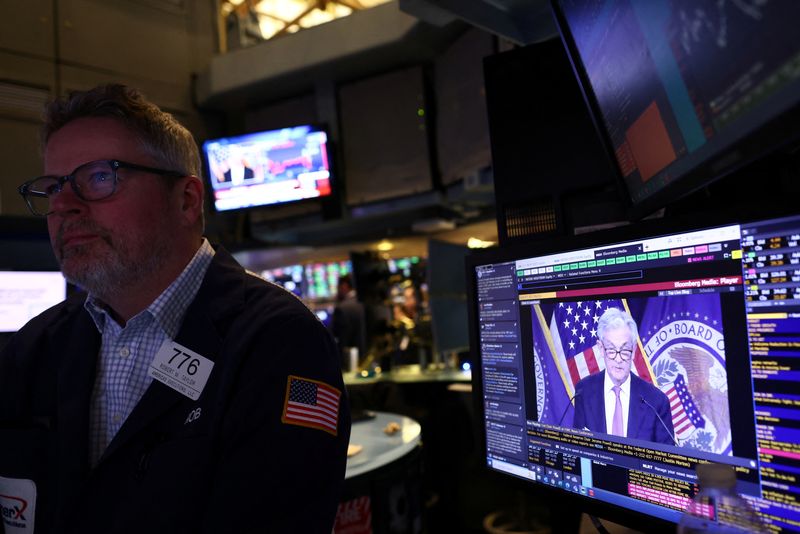By Saqib Iqbal Ahmed and Carolina Mandl
NEW YORK (Reuters) – Traders in global financial markets face extraordinary uncertainty as they await the U.S. Federal Reserve’s expected rate cut on Wednesday, setting markets up for a burst of volatility.
Major brokers expect the Fed to cut rates by 25 basis points at the end of its two-day monetary policy meeting, even as financial markets see a good chance that policymakers will start the easing cycle with a 50 basis point cut.
Fed funds futures, which reflect market expectations for the future of monetary policy, have risen, raising the probability of a rate cut by 50 basis points to 61%, up from 30% a week ago. The odds narrowed sharply after media reports revived the prospect of a more aggressive easing.
These last-minute moves have caused Fed funds futures to project an unprecedented lack of clarity on a Federal Open Market Committee decision, according to a report from BofA Global Research.
“It’s rare for the market to be divided over a Fed action 24 hours before the event,” said George Bory, chief fixed income investment strategist at Allspring.
“Typically at this point the Fed has communicated, or led the market to expect, a very specific action,” Bory said, adding that given the decision is highly uncertain, the positioning is unlikely to be profound.
While Fed decisions often move markets, the relatively even divide between traders expecting 25 bp versus 50 bp makes it likely that no matter what the Fed delivers, it will surprise many traders.
The Fed’s move will likely be the biggest surprise, compared to market prices two days before a decision, in more than 15 years, according to an analysis by Deutsche Bank.
“Nobody knows for sure… people have come up with different guesses, guesses if you will, and about half of those people are going to be wrong,” said Matt Weller, head of market research at StoneX.
“So they’re going to have to adjust their positions… One way or another, we could see some pretty big moves in the market,” Weller said.
WRINKLE EFFECT
Asset classes from equities, currencies and fixed income could all see swings in the immediate aftermath of the decision, investors said.
Stock options priced a swing of about 1.1% in either direction on Wednesday, according to options analysis service ORATS.
The recent rally in US stocks – the S&P 500 has advanced seven straight sessions, rising 4.2% – leaves stocks ill-positioned to deal with disappointment in the event of a smaller downgrade. The S&P 500 rose 0.03% on Tuesday to end just below July’s record high.
“With US stocks near all-time highs and likely already reflecting a deep Fed easing cycle, the risk-reward trade-off for much further upside looks poor,” said Tara Hariharan, director of global macro hedge fund NWI Management.
Traders, who currently expect about 120 basis points of cuts by year-end, may also have to rethink their thinking if the Fed decision and accompanying comments from Fed Chairman Jerome Powell shake their confidence in aggressive rate cuts.
“The market will need to dial back some of this pricing as the U.S. economy remains resilient,” she said, adding that she expects the front end of the yield curve to steepen.
The Fed’s decision has the potential to roil currency markets as well, with the dollar/yen pair seen as one of the most sensitive to the interest rate decision. The dollar rose almost 1% against the yen on Tuesday to 141.95.
While a 25 basis point rate cut would likely lead to a knee-jerk reaction for the US dollar, potentially pushing it back above the key 142.00 level, a 50 basis point rate cut could take the pair back to the psychologically significant 140 level. said StoneX’s Weller. said.
Glen Capelo, director of fixed income at Mischler Financial Group, expects greater interest rate volatility after the Fed’s decision as the market overextends itself.
Capelo said a 25 basis point rate cut would most likely lead to a sell-off in Treasuries, although much will also depend on the Fed’s press conference.

Michael Rosen, managing partner and chief investment officer of Angeles Investments, thinks the bond market’s interpretation of the pace of monetary policy is too aggressive.
“The market is pricing in a cut of 250 basis points in the coming year, a size that only makes sense in light of a recession. While a recession is possible in the next 12 months, it is not likely, and short-term rates will fall less than the market expects, while long-term rates could actually rise from here,” Rosen said.


